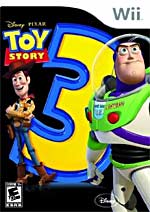As someone who grew up in the early nineties, I have fond memories of Toy Story. The first movie was certainly one of my favorites growing up, and the second movie proved to be even better than the first. Although there’s that old adage about third movies generally killing off franchises, Toy Story 3 has proved that isn’t always true. With a heart-warming story and plenty of great new characters there is plenty to love about the new movie.
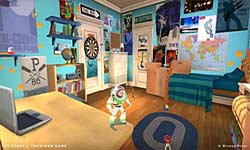
Much like the new movie, the Toy Story 3 game has gotten high praise for its combination of story elements and the new “Toy Box” mode, which allows players to roam around in an open environments playing as their favorite characters in different mission-based environments. However, while both the story and Toy Box modes are in the Wii version, there are some key differences. And if you are torn between the two versions, it is important to know about these differences beforehand.
The story mode in the Wii version of Toy Story 3 is follows the plot of the movie, and allows you to play through various plot points as Buzz, Woody, and Jessie. The game assumes familiarity with the source material, so if you haven’t seen Toy Story 3 you may be a little confused as to the actual plot of the game. The structure essentially plucks out the best “playable” scenes of the movie and lets you take a linear path through these scenes.
The single player mode features some fun platforming, but relies heavily on cooperation play. If you do not have a buddy to play with, you will have to continuously throw other characters around and drag them to different places to make sure they are where they need to be to use a special ability or activate a certain feature. In this way, the game resembles the format of the LEGO series, and if you can find a buddy to play with, it’s a much more pleasant experience.
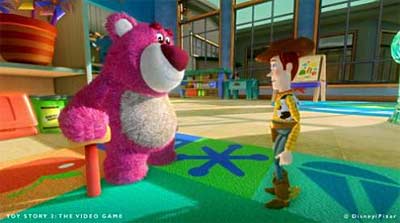
However, the most fun from the game comes from the Toy Box mode, which unfortunately is where the Wii title diverts the most from the other consoles. The Toy Box mode is structured as a free-roaming open world where users can claim missions, unlock characters, and explore new stages. All of these elements have remained intact for the Wii version, but a few key elements have been cut. For instance, much like the story mode, the Toy Box mode is a lot more fun when experienced with two players. However, in the Wii version there is no option for a second player, and all co-op missions have been axed. Another hindrance in this particular version is the scaling back of the customization elements. Though you can still customize some elements of the Toy Box, you can only choose from blanket-like customizations that change whole blocks of content instead of individual elements. Although younger players are unlikely to care about the decreased customization elements, older players may miss this feature.
Although the minimized features on the Wii version certainly disappoint, they are far from a dealbreaker. The Toy Box mode is still quite expansive and players will have a fun time unlocking new areas and characters to play with. All told, there is at least twenty hours of content in the Toy Box mode, and when you add that to the six or seven hours of gameplay time in the game, you’ve got yourself a pretty good value, especially for a licensed game.
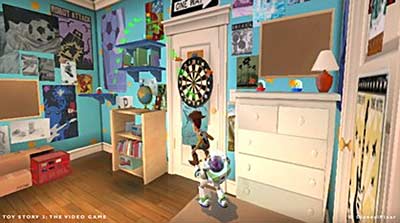
Controls in the game are fairly basic and use the standard Wii-Mote and Nunchuk setup. Use the thumbstick to move around, press A, B, Z or C to interact with the environment, and shake the Wii-mote to shove things. The controls work fairly well, but there was one small problem that I noticed almost immediately.
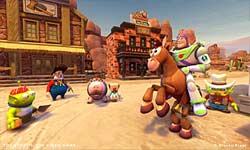
During the game, there are certain areas that require you to shoot at targets and use the Wii’s IR pointer to line up your shot. In most instances, this did not work very well and it was difficult to get your aiming reticule to settle on one spot instead of trying to target nearby objects automatically. Fortunately the IR targeting isn’t a very prevalent gameplay mechanic and I didn’t have to deal with it enough for it to be too frustrating.
As far as technical specs go, it goes without saying that the Wii version of Toy Story 3 falls short of the visual capabilities of the other console versions. However, the game still looks pretty good, and the pre-rendered cinema scenes look especially polished. The in-game world does have a few blurriness issues, and I did run into the odd graphical glitch (getting too close to a ledge caused Woody to spaz out quite often), but on the whole, the game looks pretty good. The music in the game is also fairly good. The background music in the Toy Box mode is nicely themed for the different missions and areas, and the movie-like score in the story mode is a joy to listen to. The only complaint I have with the sound (and it’s a minor one) is the prevalence of Randy Newman’s ubiquitous “You’ve Got a Friend in Me”. I know this song has an iconic status, but hearing it all the time makes this otherwise-pleasant song seem grating after a short time.
Toy Story 3 is a great movie, and surprisingly, it is a great game too. With the combination of the story mode and the Toy Box mode, there is plenty to do with this game, and users may be pleasantly surprised with exactly how much play time they will get out of this licensed title. Although the Wii falls short in the feature category when you compare it to the bigger console versions, there is still enough here for the game to stand on its own, and if you only own a Wii, this game is still worth playing in this form. If you own another console however, I would definitely choose the bigger console version first as the expanded Toy Box mode is worth the extra few dollars.
RATING OUT OF 5 RATING DESCRIPTION 3.6 Graphics
Cinema scenes look great but in-game graphics look blurry and lack detail. 3.7 Control
Controls work for platforming elements but IR targeting is shaky at best. 3.9 Music / Sound FX / Voice Acting
Music is inspired by all three films, but if you hate “You Got a Friend in Me” it’s best to keep the sound down, as that particular song is omnipresent. 4.0
Play Value
The “lite” version of the Toy Box mode is a little disappointing but the overall package has plenty of content for both the young and the young at heart to enjoy.
3.7 Overall Rating – Good
Not an average. See Rating legend above for a final score breakdown.
Game Features:
